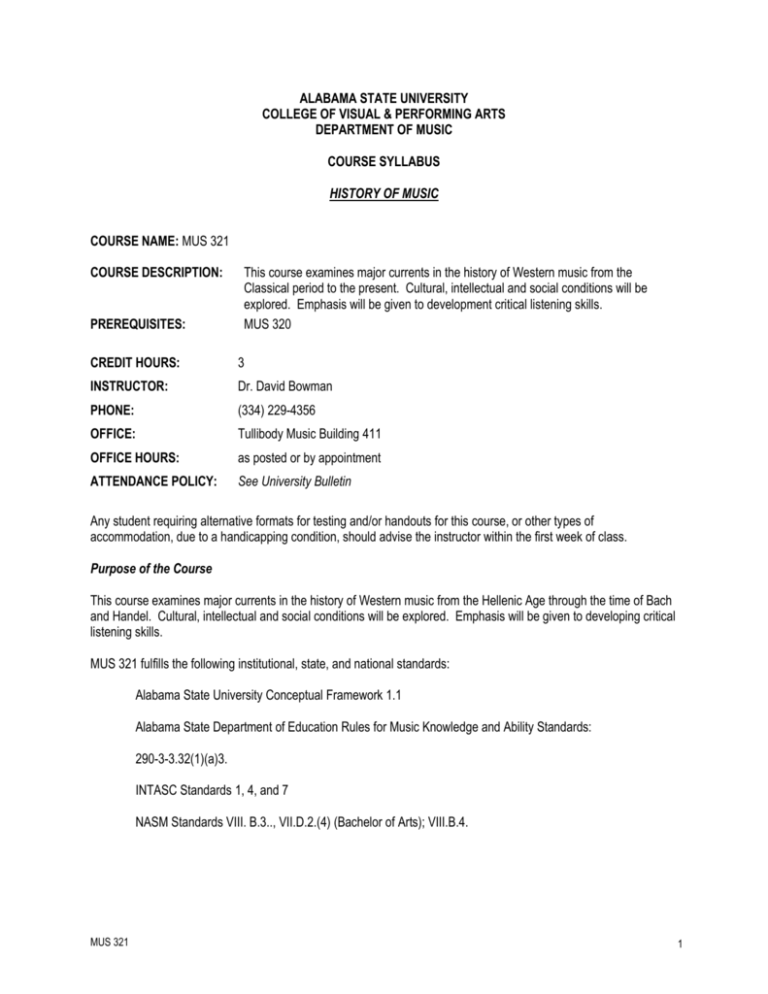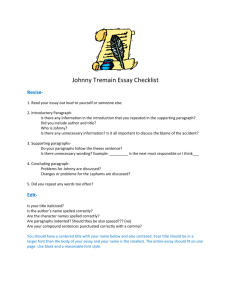MUS321 - Alabama State University
advertisement

ALABAMA STATE UNIVERSITY COLLEGE OF VISUAL & PERFORMING ARTS DEPARTMENT OF MUSIC COURSE SYLLABUS HISTORY OF MUSIC COURSE NAME: MUS 321 COURSE DESCRIPTION: PREREQUISITES: This course examines major currents in the history of Western music from the Classical period to the present. Cultural, intellectual and social conditions will be explored. Emphasis will be given to development critical listening skills. MUS 320 CREDIT HOURS: 3 INSTRUCTOR: Dr. David Bowman PHONE: (334) 229-4356 OFFICE: Tullibody Music Building 411 OFFICE HOURS: as posted or by appointment ATTENDANCE POLICY: See University Bulletin Any student requiring alternative formats for testing and/or handouts for this course, or other types of accommodation, due to a handicapping condition, should advise the instructor within the first week of class. Purpose of the Course This course examines major currents in the history of Western music from the Hellenic Age through the time of Bach and Handel. Cultural, intellectual and social conditions will be explored. Emphasis will be given to developing critical listening skills. MUS 321 fulfills the following institutional, state, and national standards: Alabama State University Conceptual Framework 1.1 Alabama State Department of Education Rules for Music Knowledge and Ability Standards: 290-3-3.32(1)(a)3. INTASC Standards 1, 4, and 7 NASM Standards VIII. B.3.., VII.D.2.(4) (Bachelor of Arts); VIII.B.4. MUS 321 1 Instructional Objectives Students will: A. Know the key developments in the evolution of style in the early Classical Period. B. Know the key elements of music in the late eighteenth century. C. Know the important characteristics of the music of Ludwig van Beethoven. D. Know the essential characteristics of vocal music in the nineteenth century. E. Know the key elements of instrumental music in the nineteenth century. F. Know the essential characteristics of opera in the nineteenth century. G. Know the key characteristics of the rising tide of Nationalism of the late nineteenth century. H. Know the various characteristics of early twentieth century musical style. I. Know key elements of mid-twentieth century music. J. Know the important trends of music after 1950. K. Identify by composer, title, and movement (where applicable) listening examples heard in class sessions. L. Based on listening examples heard in class, ascertain the style of unknown compositions. Discern possible composer and/or period of composition. M. Distinguish between overall styles of the various period through the use of computer sessions and computer use. Evaluation and Minimum Standards Students will be required to take all examinations, including the final. Students will be required to adhere to the university policy on attendance. Objectives A and B will be tested on test one. There will be 25 questions. The student must correctly answer 18 of the 25 questions to pass this objective. Objective C will be tested on test two. There will be 40 questions. The student must correctly answer 25 of the 40 questions to pass this objective. Objective D will be tested on test three. There will be 35 questions. The student must correctly answer 25 of the 35 questions to pass this objective. Objectives E and F will be tested on test four. There will be 20 questions and one essay question from Objective F. The student must correctly answer 14 of the 20 questions and at least 7 of the ten points on the essay question to pass this objective. The essay will be graded both on content and grammar, and the student must pass the essay. Objective G will be tested on test five. There will be 50 questions. The student must correctly answer 35 of the 50 questions to pass this objective. Objectives H and J will be tested on test six. There will be 50 questions. The student must correctly answer 35 of the 50 questions to pass this objective. Objective I will be tested on test seven. There will be 50 questions. The student must correctly answer 35 of the 50 questions to pass this objective. Objective J will be tested on test eight. There will be 50 questions. The student must correctly answer 35 of the 50 questions to pass this objective. Objective K will be evaluated on tests 1-7. There will be 50 examples. The student must correctly answer 15 of the 20 questions to pass this objective. Objective L will be evaluated on test seven. There will be a total of 10 examples. The student must correctly answer 7 of the 10 to pass this objective. Final Exam: the final examination will be comprehensive and will contain a total of 60 objective questions and two essay questions. Both essay questions will be worth 10 points each. For the essay o be considered correct, the student must achieve 7 of the 10 for each essay. Questions will be grade on content and language. Also, in order to pass the final, the student must correctly answer 42 of the 60 objective questions and one of the essay questions. MUS 321 2 Grading To receive a grade of A, the student must achieve the minimum standards for all 14 objectives, and correctly answer at least 54 of the 60 objectives and both essay questions on the final examination. To receive a grade of B, the student must achieve the minimum standards for 13 of the 14 objectives, and correctly answer at least 48 of the 60 objectives and both essay questions on the final examination. To receive a grade of C, the student must achieve the minimum standards for 12 of the 14 objectives, and correctly answer at least 42 of the 60 objectives and both essay questions on the final examination. To receive a grade of D, the student must achieve the minimum standards for 10 of the 14 objectives, and correctly answer at least 35 of the 60 objectives and both essay questions on the final examination. Failure to achieve minimum standards for the grade of D will result in a grade of F. Course Requirements and Materials Attendance: Regular class attendance and participation is required. Text: A Concise History of Western Music, Barbara Russano Hanning. W.W. Norton. MUS 321 3





